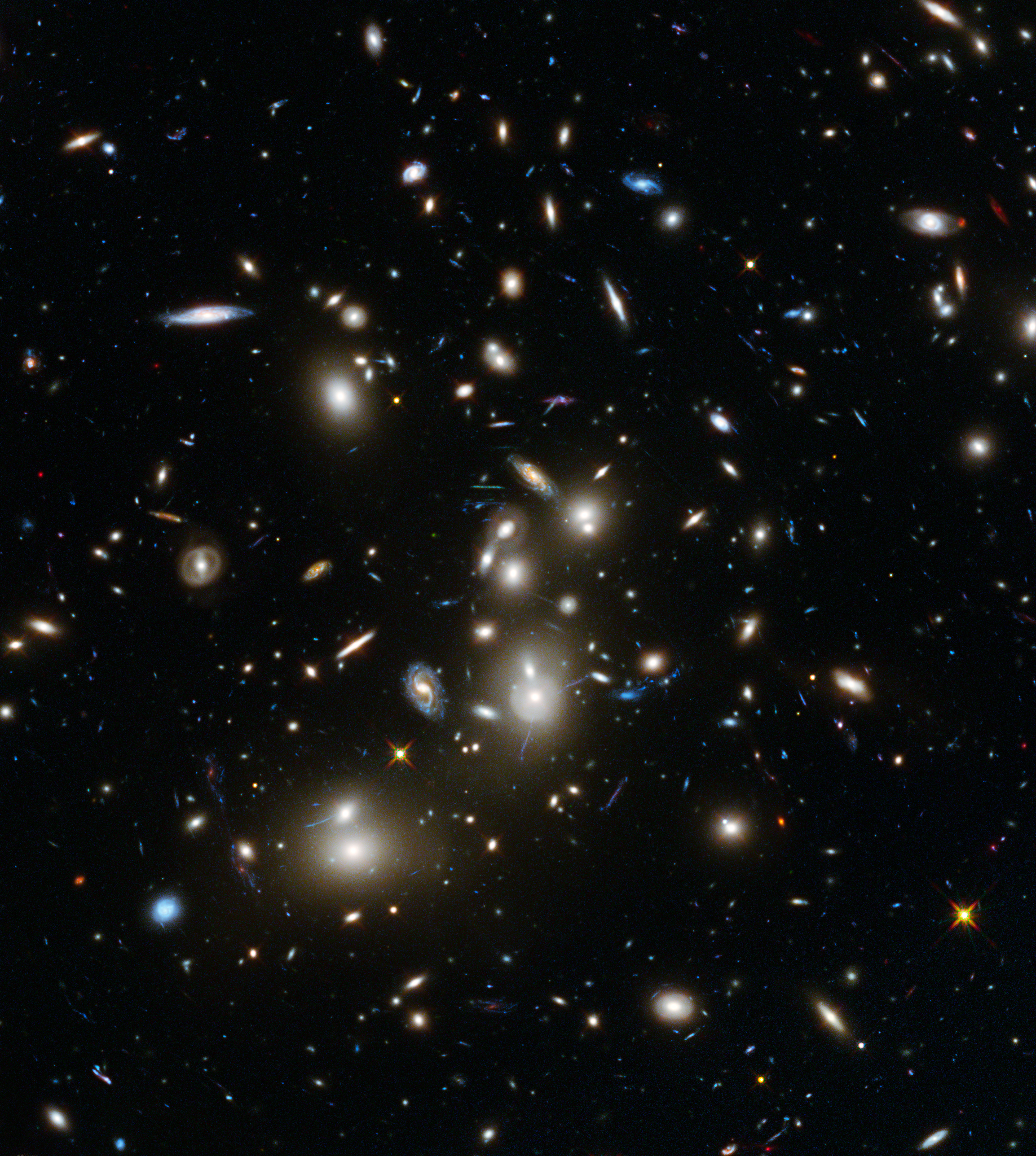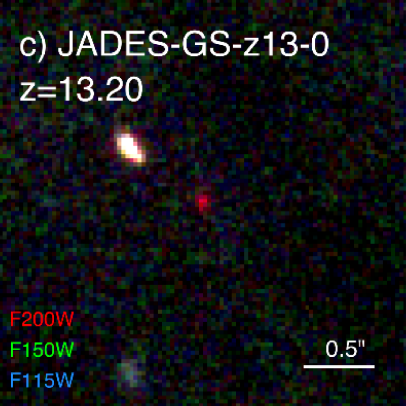|
XMMXCS 2215-1738
XMMXCS 2215-1738 is a galaxy cluster that lies 10 billion light-years away and has a redshift value of z=1.45. It was discovered by the XMM Cluster Survey in 2006.http://www.physorg.com/news68820846.html ''Massive galaxy cluster found 10 billion light years away'' June 6th, 2006, ''Space & Earth'' magazine Discovered in 2006, XMMXCS 2215-1738 is one of the most distant galaxy clusters known. It is embedded in intergalactic gas that has a temperature of 10 million degrees. The estimated mass of the cluster is 500 trillion solar masses, most coming from dark matter. The cluster was discovered and studied using the ''XMM-Newton'' and Keck Telescopes. The cluster is surprisingly large and evolved for a cluster that existed when the universe was only 3 billion years old. Led by University of Sussex researchers, part of the XMM Cluster Survey (XCS) used X-ray Multi Mirror (XMM) Newton satellite to find it, Keck Telescope to determine distance, and used the Hubble Space Telescope to ... [...More Info...] [...Related Items...] OR: [Wikipedia] [Google] [Baidu] |
Aquarius (constellation)
Aquarius is an celestial equator, equatorial constellation of the zodiac, between Capricornus and Pisces (constellation), Pisces. Its name is Latin for "water-carrier" or "cup-carrier", and its old astronomical symbol is (♒︎), a representation of water. Aquarius is one of the oldest of the recognized constellations along the zodiac (the Sun's apparent path). It was one of the 48 constellations listed by the 2nd century astronomer Ptolemy, and it remains one of the 88 modern constellations. It is found in a region often called the Sea (astronomy), Sea due to its profusion of constellations with watery associations such as Cetus the whale, Pisces (constellation), Pisces the fish, and Eridanus (constellation), Eridanus the river. At apparent magnitude 2.9, Beta Aquarii is the brightest star in the constellation. History and mythology Aquarius is identified as "The Great One" in the Babylonian star catalogues and represents the god Ea (god), Ea himself, who is commonly depic ... [...More Info...] [...Related Items...] OR: [Wikipedia] [Google] [Baidu] |
Keck Telescope
The W. M. Keck Observatory is an astronomical observatory with two telescopes at an elevation of 4,145 meters (13,600 ft) near the summit of Mauna Kea in the U.S. state In the United States, a state is a constituent political entity, of which there are 50. Bound together in a political union, each state holds governmental jurisdiction over a separate and defined geographic territory where it shares its sove ... of Hawaii. Both telescopes have aperture primary mirrors, and when completed in 1993 (Keck 1) and 1996 (Keck 2) were the List of largest optical reflecting telescopes, largest astronomical telescopes in the world. They are currently the 3rd and 4th largest. Overview With a concept first proposed in 1977, telescope designers at the University of California, Berkeley (Terry Mast) and Lawrence Berkeley Laboratory (Jerry Nelson (astronomer), Jerry Nelson) had been developing the technology necessary to build a large, ground-based telescope. With a design in h ... [...More Info...] [...Related Items...] OR: [Wikipedia] [Google] [Baidu] |
List Of Galaxy Clusters
This article lists some galaxy groups and galaxy clusters. Defining the limits of galaxy clusters is imprecise as many clusters are still forming. In particular, clusters close to the Milky Way tend to be classified as galaxy clusters even when they are much smaller than more distant clusters. Clusters exhibiting strong evidence of dark matter Some clusters exhibiting strong evidence of dark matter. Named groups and clusters This is a list of galaxy groups and clusters that are well known by something other than an entry in a catalog or list, or a set of coordinates, or a systematic designation. Clusters Groups The major nearby groups and clusters are generally named after the constellation they lie in. Many groups are named after the leading galaxy in the group. This represents an ad hoc systematic naming system. Groups and clusters visible to the unaided eye The Local Group contains the largest number of visible galaxies with the naked eye. However, it ... [...More Info...] [...Related Items...] OR: [Wikipedia] [Google] [Baidu] |
List Of The Most Distant Astronomical Objects
This article documents the most distant astronomical objects discovered and verified so far, and the time periods in which they were so classified. For comparisons with the light travel distance of the astronomical objects listed below, the age of the universe since the Big Bang is currently estimated as 13.787±0.020 Gyr. Distances to remote objects, other than those in nearby galaxies, are nearly always inferred by measuring the cosmological redshift of their light. By their nature, very distant objects tend to be very faint, and these distance determinations are difficult and subject to errors. An important distinction is whether the distance is determined via spectroscopy or using a photometric redshift technique. The former is generally both more precise and also more reliable, in the sense that photometric redshifts are more prone to being wrong due to confusion with lower redshift sources that may have unusual spectra. For that reason, a spectroscopic redshift is conventio ... [...More Info...] [...Related Items...] OR: [Wikipedia] [Google] [Baidu] |
2XMM J083026+524133
2XMM J083026+524133 (2XMM J0830) is a very large galaxy cluster that lies 7.7 billion light-years away. It was discovered by chance by ESA's XMM Newton and the Large Binocular Telescope (LBT) in Arizona in 2008 while it was looking at the quasar APM 08279+5255. As of 2008, it was the largest known galaxy cluster at red shift z ≧ 1, weighing in at an estimated 1015 solar masses. However, galaxy cluster XMMXCS 2215-1738 is several billion light years farther away. June 6th, 2006, Space & Earth magazine References See also * * |
Hubble Space Telescope
The Hubble Space Telescope (often referred to as HST or Hubble) is a space telescope that was launched into low Earth orbit in 1990 and remains in operation. It was not the first space telescope, but it is one of the largest and most versatile, renowned both as a vital research tool and as a public relations boon for astronomy. The Hubble telescope is named after astronomer Edwin Hubble and is one of NASA's Great Observatories. The Space Telescope Science Institute (STScI) selects Hubble's targets and processes the resulting data, while the Goddard Space Flight Center (GSFC) controls the spacecraft. Hubble features a mirror, and its five main instruments observe in the ultraviolet, visible, and near-infrared regions of the electromagnetic spectrum. Hubble's orbit outside the distortion of Earth's atmosphere allows it to capture extremely high-resolution images with substantially lower background light than ground-based telescopes. It has recorded some of the most detaile ... [...More Info...] [...Related Items...] OR: [Wikipedia] [Google] [Baidu] |
X-ray Multi Mirror
''XMM-Newton'', also known as the High Throughput X-ray Spectroscopy Mission and the X-ray Multi-Mirror Mission, is an X-ray space observatory launched by the European Space Agency in December 1999 on an Ariane 5 rocket. It is the second cornerstone mission of ESA's Horizon 2000 programme. Named after physicist and astronomer Sir Isaac Newton, the spacecraft is tasked with investigating interstellar X-ray sources, performing narrow- and broad-range spectroscopy, and performing the first simultaneous imaging of objects in both X-ray and optical (visible spectrum, visible and ultraviolet) wavelengths. Initially funded for two years, with a ten-year design life, the spacecraft remains in good health and has received repeated mission extensions, most recently in October 2020 and is scheduled to operate until the end of 2022. ESA plans to succeed ''XMM-Newton'' with the Advanced Telescope for High Energy Astrophysics (ATHENA), the second large mission in the Cosmic Vision 2015–2025 p ... [...More Info...] [...Related Items...] OR: [Wikipedia] [Google] [Baidu] |





